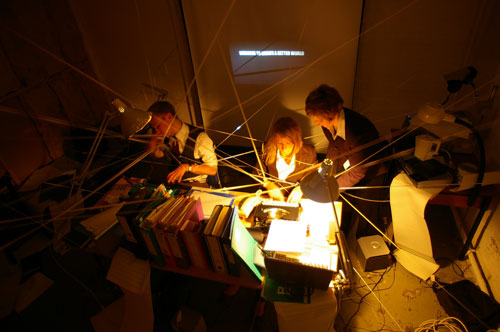Art Space + Nature is a unique, interdisciplinary course that was started in 2003. Seven years later, the course’s objectives continue to be in a flexible and formative state. Unlike most degree courses, which are classified by formalist media (i.e. sculpture, painting, printmaking, etc) Art, Space +Nature’s trans-departmental qualities make it difficult to describe. The program is run through Edinburgh College of Art’s School of Landscape Architecture and was created in collaboration with the department of Painting and Drawing. The goal of the course is for artists and architects to engage with the landscape and built environment through both research and fieldwork exercises. The program runs with minimal access to studio space, promoting students to work outside of the college and often in international contexts.
Art, Space + Nature, more commonly referred to as ASN, does not identify with a particular artistic medium; there are no required classes or reading lists. The day-to-day structure is completely determined by the current students, which consists of a diverse body of architects, landscape architects, and visual artists.
In all honesty, the main reason I chose to enroll in ASN was a fascination with its title. Not just the singular words (art, space, nature,) but the simultaneous question and equation that they form. Defining the course title is a project in and of itself that can take on multiple forms and personas. It is a project that ASN students constantly entertain.
Now that I have graduated, I have the more challenging task of explaining the meaning of ASN to potential employers and colleagues. Traditionally, there is a notion that a post-graduate degree signifies a specialization or “mastery” over a particular subject. In an interdisciplinary program, each student is required to define his or her own, individual area of specialization. The program thus takes on chameleon-like characteristics that do not lend themselves to a line on a résumé or cover letter as well as they do in an extended conversation.
While the name “Art, Space + Nature” is unique to the Edinburgh College of Art, other art institutions have come up with an unending supply of names for the same type of program: Open Media, New Media, Transmedia. Where you work or study, it might be known as _____________. In short, a clear case of an interdisciplinary-identity crisis is revealed.
This inability to commit to a discipline reminds me of an article I read, defining our society as a generation of desultors (a term used as early as Homeric times to describe a man who keeps four horses abreast at full gallop and leaps from one to another, amidst a crowd of admiring spectators). Since reading the article, the vision of a desultor has not escaped me…the feeling that I, too, am on a race circuit, leaping from one horse to another (though in this case, each horse signifies a different school of thought, theory, or practice).
A desultor demonstrates skill but also restlessness. There is no definitive reason for riding more than one horse, and certainly riding one horse is a much easier task. But… a desultor is an artist and where rational falls short, the imagination runs wild. Alan Johnston, one of the core founders of Art, Space + Nature, frequently refers to the philosophy of Ad Reinhardt, and quotes him in saying, “a fine artist needs a fine mind.” This being said, the overriding goal in interdisciplinary study is to engage, to practice, to learn, and to question by any means necessary. When the boundaries between formal art disciplines begin to erode, new practices and ideas will have room to develop.
